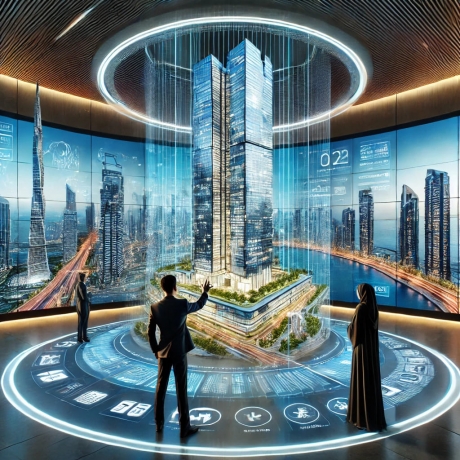In the ever-evolving landscape of Dubai's real estate market, 2024 marks a revolutionary year with the advent of holographic visualizations. This cutting-edge technology is redefining how properties are presented, offering potential buyers and investors a glimpse into the future like never before. As Dubai continues to set global benchmarks in architectural innovation and technological integration, holographic presentations are poised to become the new standard in the industry.
The Emergence of Holographic Technology in Real Estate
Holographic technology, which creates three-dimensional images that can be viewed without special glasses, has seen significant advancements in recent years. Initially popularized in entertainment and advertising, it is now making waves in the real estate sector. Leading developers in Dubai are adopting this technology to create immersive, interactive experiences for their clients.
Holographic visualizations allow potential buyers to explore properties in a highly detailed and realistic manner. Unlike traditional 2D renderings or even 3D models, holograms provide a depth and realism that is unparalleled. Clients can walk through a virtual space, view it from different angles, and even interact with various elements, such as changing wall colors or rearranging furniture, all in real-time.
Benefits for Buyers and Developers
For buyers, the advantages of holographic visualizations are clear. This technology offers a much more accurate representation of a property than traditional methods. Prospective homeowners can get a true sense of the space, its layout, and its ambiance, leading to more informed purchasing decisions. Additionally, it saves time and resources by allowing buyers to "visit" multiple properties from a single location, without the need for physical travel.
Developers also stand to gain significantly from this technology. Holographic presentations can accelerate the sales process by providing a "wow" factor that traditional methods lack. It enables developers to showcase their projects in a more compelling and engaging way, attracting potential buyers and investors more effectively. Moreover, this technology can be particularly beneficial for off-plan properties, where the physical structure has not yet been completed. Holograms can bring these future projects to life, helping to secure sales and investments well before construction is finished.
Case Study: Emaar's Pioneering Use of Holograms
Emaar Properties, one of Dubai's leading real estate developers, has been at the forefront of incorporating holographic technology into their marketing strategies. Their recent project, The Dubai Creek Tower, serves as a prime example. Emaar used holographic visualizations to present the tower's design, features, and surrounding landscape to potential buyers and investors.
Visitors to Emaar's sales center were greeted with a life-sized hologram of the tower, allowing them to experience the grandeur and scale of the project firsthand. They could explore the tower's various floors, amenities, and even view the panoramic skyline views from different heights. This innovative approach not only generated significant buzz but also led to a notable increase in pre-sales.
The Future of Holographic Real Estate Presentations
As holographic technology continues to evolve, its applications in real estate are expected to expand even further. Future developments may include fully interactive virtual neighborhoods, where buyers can explore entire communities, including parks, shops, and public spaces, all in holographic form. Additionally, advancements in artificial intelligence could enable even more personalized and interactive experiences, tailored to the specific preferences and needs of each client.
The integration of holographic visualizations in Dubai's real estate market is a testament to the city's commitment to innovation and excellence. As this technology becomes more widespread, it will undoubtedly transform how properties are marketed and sold, setting a new standard for the industry globally.
In conclusion, the rise of holographic visualizations in Dubai's real estate market represents a significant leap forward in property presentation and sales. This technology not only enhances the buying experience but also provides developers with powerful tools to showcase their projects in a compelling and immersive way. As we look to the future, it is clear that holograms will play a crucial role in shaping the next generation of real estate marketing and development.






